The League is committed to working with California State Parks to tell a more complete history of our founders and ensure parks are welcoming to all
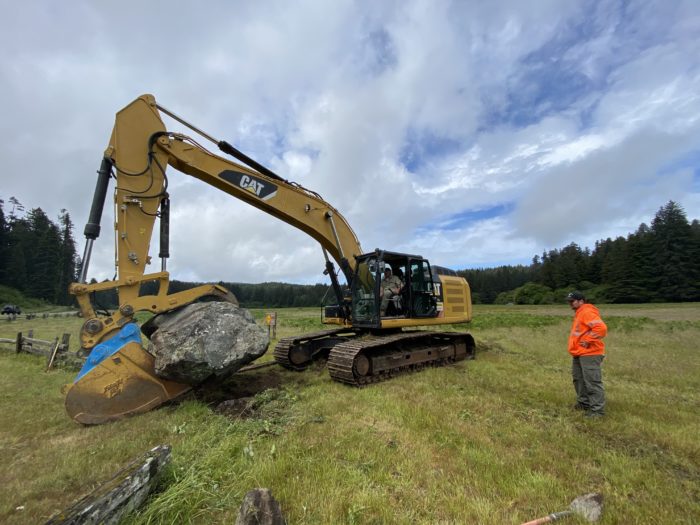
A key moment in the history of the American conservation movement took place more than a hundred years ago in a magnificent grove of coast redwoods called Bull Creek Flat in what is now Humboldt Redwoods State Park. It is a story that the League has long told about John C. Merriam, Henry Fairfield Osborn, and Madison Grant being inspired to launch Save the Redwoods League and leverage their power and resources to elevate the movement to protect the ancient forest from the axe. The work that followed ultimately safeguarded many thousands of acres of old-growth coast redwoods and giant sequoia and gave millions of future visitors the opportunity to experience these natural treasures. The legacy of these men is memorialized in a number of plaques, signs, and interpretive exhibits throughout the north coast redwoods.
It is now well past time to rethink those memorials and tell the whole story. This work began in earnest during the summer of 2019, when California State Parks approached the League with concerns about the narrow story being told on interpretive signs at Founders Grove in Humboldt Redwoods State Park. We collaborated to remove two signs and replaced them with one that both broadens the context and definition of “founders” and provides a more complete history of the values of Grant, Osborn, and Merriam. They were leaders and participants in the discriminatory and oppressive pseudoscience of eugenics in the early 20th century, and many of their racist and exclusionary beliefs permeated the conservation movement they helped advance.
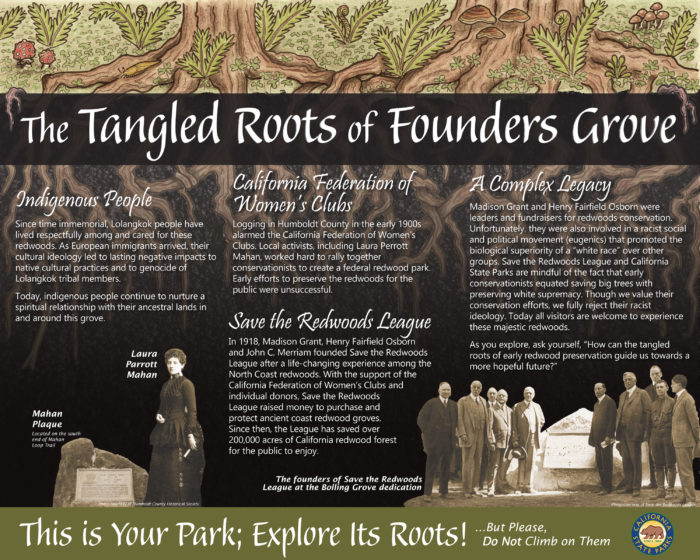
Save the Redwoods League disavowed our founders’ beliefs long ago, and in recent years we’ve realized that we must be much more proactive in our reckoning with the erasure and harm that results from putting these people on a pedestal. First, we needed to publicly acknowledge the dangerous beliefs of our founders and the role they played in our history. Likewise, we feel strongly that the memorials to our founders that exist throughout the parks should either be removed or updated.
Signs and names are important. How we choose to interpret resources and history as well as how places are named makes a tremendous difference to those who encounter them. If we want a future where everyone feels genuinely welcome at redwood and giant sequoia parks, then we can’t ignore or promote values that are oppressive at their core.
Recently, another of these memorials came down with the full support of the League. This was a memorial rock in Prairie Creek Redwoods State Park honoring Madison Grant. The rock dated from the 1948 establishment of the Madison Grant Forest and Elk Refuge. Save the Redwoods League has worked closely with California State Parks on a new interpretive exhibit for the spot that will explain why the rock was removed and give a fuller accounting of Grant’s legacy. The initial impetus for this particular action was a letter signed by a number of historians and professors calling for action on changing the names of the Madison Grant Forest and Elk Refuge among other monuments in Humboldt Redwoods State Park. We are grateful for the shared expertise and relationship that emerged with those professors, and we welcome community input, ideas, and accountability on this journey.
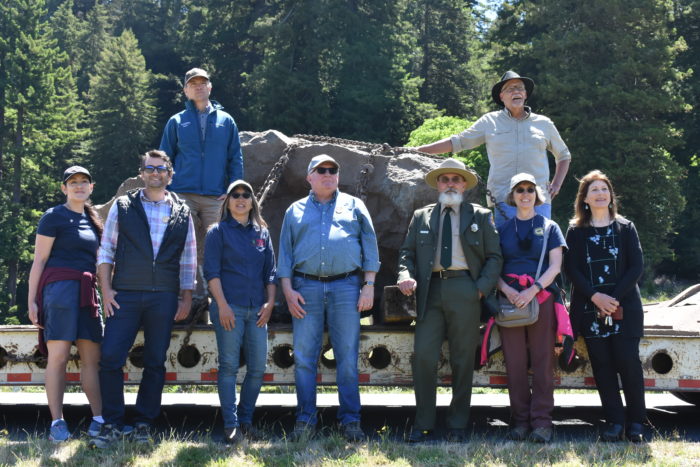
The removal of historical monuments honoring Confederate generals and others whose beliefs are now recognized as abhorrent has been surrounded by controversy. There are those who argue that these monuments simply reflect history and a past value system, and thus should remain. We believe they tell a singular and often inaccurate story from a privileged perspective that actively marginalizes other lived experiences. This is counter to our values of diversity, equity, and inclusion, and we must do better.
There is much more work to be done with regard to the interpretation of and the memorials to League founders. We are advancing renovations at Founder’s Grove itself in the near future, and the League and California State Parks will work closely together to ensure a thorough representation of the past. And we hope this will be part of a larger movement to engage historically excluded communities in the visioning and storytelling of these treasured places.

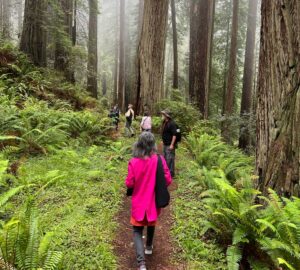
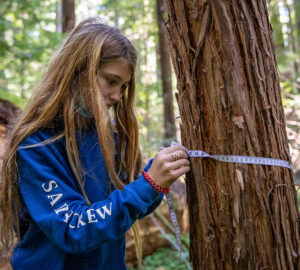
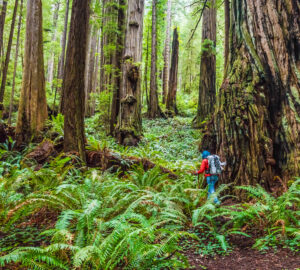
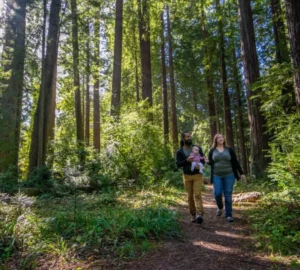
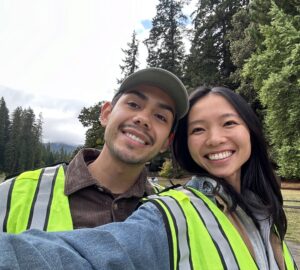
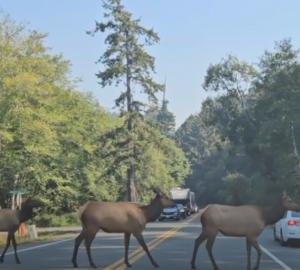
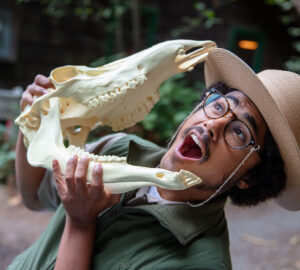
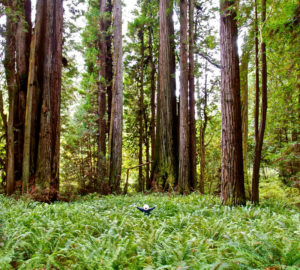
9 Responses to “Rethinking monuments to the League’s founders”
Pat Kittle
I have dedicated my life to saving the redwoods, as anyone who knows me will verify.
I happen to be a White straight gentile male — a group judged far more harshly today than any other group — even as we are supposedly at the apex of “privilege.”
Vastly unsustainable human population growth is the ULTIMATE threat to redwoods & the rest of the biosphere, which is why I remain childless. But the League has absolutely nothing to say about that! WHY??
Even constructive criticism is now banned if it doesn’t comply with the League’s new “woke” agenda, which is why I’ll be surprised if this FACTUAL comment is not censored.
Victor Kamendrowsky
A clear distinction between thought and action is essential. The Confederate generals not only harbored moral and intellectual rot; they also betrayed their country and were responsible for the deaths of thousands. The Union carpetbaggers who betrayed the freed slaves were despicable. As to racism, eugenics, and antisemitism, they were, and still are, so widespread we might as well rename our species.
Jason Courtis
The revision of a history written by straight white men is essential right now. Transforming our interpretation of the past is powerful and much needed work. And… censorship terrifies me. I am longing for these monuments to deeply flawed and inhumane historical ideas (represented by certain historical figures) to not be swept away under the carpet, (out of sight, out of mind, phew, we no longer have to be confronted by that piece of our past…) but creatively reimagined by BIPOC artists, built on, transformed, transcended. I think removal is too easy, too simple, not wrestling with the complex, excruciating reality around ‘race’ and racism. And I fully accept, as a white person, to be told by the BIPOC community that what is wanted and needed is removal. May they be at the center of these decisions.
Alexandra Florimonte
I am so impressed with the efforts to re-visit our monuments and signage in the parks and treasured places of California with ones that acknowledge past controversial beliefs and try to rectify the exclusionary policies of those beliefs. It is often painful to do so, but it’s certainly about time to speak out for a new set of inclusionary beliefs and policies.
John Griffith
Love this! It’s very inspiring. Thanks, SRL!
Gail Adams
If PETA or something like it ever convinces the people of America to no longer use animals for food, clothing, or amusement, will we see all statues of previous “unenlightened people” torn down. Our league’s founders thought that they were going to improve the human condition. Eugenics is unpopular now, but in the past it was popular. One of the main characters in the opera Carmen is a bullfighter – will you no longer listen to it? Honor people for the good things that they have done, and ignore what we no longer approve of.
Ramona Raybin
Perhaps I am alone in thinking that I would prefer that the League focus finances and resources on the work of managing and restoring the redwood forests rather than changing or removing monuments to the founders. While learning some of their personal beliefs were, even at that time abhorrent, they are dead and gone. What matters to me is that they founded the Save the Redwoods League (a good thing).
Norman Howard
A story that needs to be told. But hope there is some nuance – eg is it possible that but for these founders, the park might be a shopping mall or something similar today ? It would be comforting if non controversial people saved the redwoods, but life doesn’t work that way. But reinterpretation is absolutely warranted .
Levin Messick
Wow! Look at all the white faces on the board!